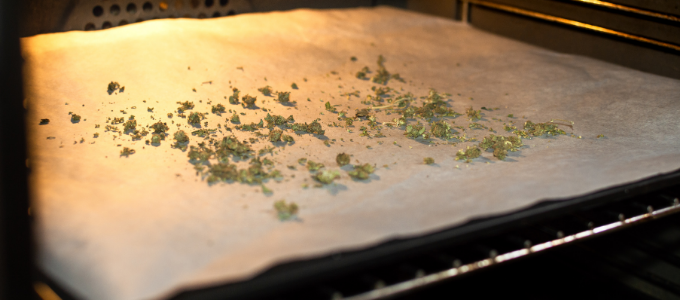
Heat exposes the cannabinoids in your weed to decarboxylation. "Decarbing" your weed is a process that changes the chemical structure of the chemical compounds in cannabis to become more available to the bloodstream. That’s the simple part. In this guide, we discuss a bit of the chemistry and focus on proper decarboxylation of your weed at home.

Ever wondered why marijuana is more commonly smoked? How about expressed curiosity as to why edibles get you high, yet eating raw marijuana does not?
The most forward conclusion one could make would be that heat and temperature conditions must have something to do with this phenomenon - and they’d be 100% right! This process is called decarboxylation.
Decarboxylation put in simple chemical terms, implies that we remove a carbon atom and oxygen atom from a molecule (hint: it’s THCa). By heating cannabis, this causes these bonds to break within the THCa molecule, converting it to THC.
That’s a simplification, yet it’s important to have a basic idea of the full concept before we dive further.
Now that we know the removal of an oxygen atom and carbon atom via heat from the cannabis plant allows certain compounds to become more available to the body, but what does that mean?
Cannabis contains hundreds of naturally occurring chemical compounds. Some provide an effect on the body, others are purely aroma, while others do not really do anything we are aware of yet. Not all of these compounds are cannabinoids, there are terpenes, flavonoids, among other compounds that make up the flavor and aroma of fresh cannabis and cannabis products.
Cannabinoids such as THCa and CBDa exist in the raw flower in greater quantities - naturally. The problem: While these two cannabis compounds do have some appreciable medical benefits, it is their decarboxylated family members THC and CBD that produce the greatest benefit to medical patients and the best experience for recreational consumers.
Decarboxylation of your weed removes the chemical bond preventing the cannabinoid THC, among others, from readily entering the bloodstream. Put another way, decarboxylation activates the THC and CBD.
Cannabis distillate is among the few types of cannabis product that comes activated (i.e. - decarboxylated) from the dispensary. If you plan on making edibles with anything else, "decarbing" your weed is 100% necessary.
Eating marijuana fresh flower will not produce any of the psychoactive effects associated with smoking or vaporization. Decarboxylation is therefore one of the most important parts of the edible production process. With a good method, making edibles, tinctures, or other non-smoked products at home is both fun and consistent.
Decarboxylation allows cannabinoids to more freely enter the bloodstream. Because food goes through the stomach and smoke goes through the lungs, there are different enzymatic processes in the body for processing the THC.
Edibles do take longer to kick in as a result of their different process of absorption. Just keep in mind the experience and the timeframe are much different with edibles than with smoking or vaporization.
Decarboxylation of weed, known colloquially as "decarbing," is essential for THC, CBD, or various other less prominent cannabinoids to be available to the body without smoking or vaporizing the product. Decarbed weed can be used to infuse oils; it can be easily added to salad dressings and sauces, and it can consistently produce the experience recreational cannabis enthusiasts are seeking.
This process can be done with fresh flower and concentrates. As mentioned above, cannabis distillate does not need to be decarboxylated. There is a good reason, but it’s not one we will explore here (because we explored it here).

Measure out the desired amount of weed for proper decarboxylation. This varies by both the user and the intended dose. Let’s run through a piece of math quickly:
3.5 grams is equal to 1/8th of an ounce
The cannabis is 20 percent THCa, meaning per 1000 milligrams of full flower (or 1 gram) there is 200 milligrams of THCa.
This means per 1/8th ounce, there are 700mg of THCa
** it should be noted that THCa does not 100% convert to THC. It’s generally good to estimate the final THC will be roughly 25 percent less than the initial THCa.
700mg THCa * 0.25 loss = 175mg loss
700mg THCa - 175mg THCa = 525mg THC after decarboxylation
Under environmental conditions, cannabis would grow, it would produce flower, and die. After the plant is dead, the remaining plant would continually be exposed to oxygen. A process of oxidation would eventually cause the THCa to lose an oxygen and carbon molecule, becoming THC. This process is expedited greatly by adding heat.
We've found the temperature 220 degrees Fahrenheit (~104 Celsius) for 55 minutes - 1 hour 5 minutes consistently delivers a bright experience rather than a burnt one.
Preheat the oven so the timer is as accurate as possible. The goal is to minimize the loss of THC and maximize flavor.
If you are using fresh cannabis flower, grind it finely and evenly. If you are using concentrates, depending on the quantity, the most important part is you have a tool to scrape it from the container.
Use an oven-safe container such as a Pyrex container. Spread the cannabis flower or concentrate evenly across the container. Some recommend putting tinfoil or a cover over the container, others don’t. We think it is up to preference.

Pop that pot in the oven for 55 minutes to 1 hour 5 minutes. At the 25 minute mark, stir your flower and concentrates. This helps ensure even decarboxylation. At the hour mark, remove from the oven and let sit for five to ten minutes.












